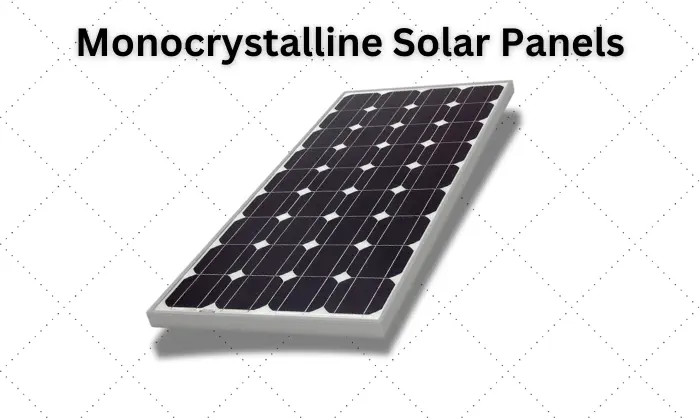What Are Monocrystalline Solar Panels?
Monocrystalline solar panels are a type of photovoltaic (PV) panel suitable for rooftops and off-grid applications. The term PV panel refers to a solar panel because each one contains interconnected photovoltaic cells.
Monocrystalline panels are one type of PV panel, and there are three main types, each differing in efficiency: Monocrystalline panels are the best, polycrystalline or poly panels are second best, and thin-film panels are the least efficient.
Monocrystalline solar panels have a reputation for their durability, efficiency, and power output ratings. They can even perform well in low light conditions.
They are also more space efficient than polycrystalline. Their octagonal shape allows for more solar cells to fit into one panel. This reduces wasted space which leads to higher electricity production.
Why are Monocrystalline Solar Panels the Best?

Monocrystalline solar panels are good for homes and businesses because they save space and work well in low light. They are also a popular choice for warm weather because they tend to perform better in heat than other solar panel types. Most people choose efficient solar panels with long lifespans for their property’s energy system.
Manufacturers create mono solar panels by cutting single-crystal silicon into thin wafers. Workers assemble these wafers together to form rectangular cells in each panel. The cells connect to each other, a junction box, and cables to create a solar panel. They install the solar panel on rooftops or poles.
Monocrystalline solar panels produce more power than other types. This is because their silicon crystals have a larger surface area. This larger surface area helps generate more electricity. Single-crystal silicon makes the wafers, helping electrons move easily and generate electricity.
Monocrystalline solar panels are very efficient. They can generate 20% more energy per square foot than other types of solar panels. They can also withstand high temperatures and have a longer projected lifespan than other solar panel types. This is why they typically have a 25-year warranty and are the most popular solar panel option for homeowners.
Efficiency Rate
Monocrystalline solar panels produce more electricity and power in the same space compared to polycrystalline panels. This makes them ideal for homes with limited roof space and people who want to maximize their energy savings. Also, they work well in hot weather and are ideal for areas with moderate to warm climates.
When deciding which solar panel type to purchase, homeowners should consider space constraints, their budget and personal preferences. Both mono and poly solar panels are efficient and will save money on electricity bills in the long run. The choice between the two types does not affect their ability to save money.
However, mono panels tend to have a higher upfront cost than polycrystalline solar panels. Optivolt’s Kalyanpur says you can save money and still get efficient monocrystalline solar panels by finding creative solutions.
Manufacturers make monocrystalline solar cells from one pure silicon ingot, and they make polycrystalline panels from multiple silicon fragments. They then cut them into wafers and add a layer of phosphorus. Each panel contains between 32 and 96 pure silicon wafers, which workers assemble to create the solar panels.
As a result, they have the highest conversion efficiency of all solar panel types. They also have high performance in low light levels and are less affected by temperature.
How do Monocrystalline PV panels work?
As the name suggests, monocrystalline solar panels utilize single-crystal silicon cells to transform sunlight into energy. They are the highest-efficiency PV panels available. They produce more energy per square foot and require less upkeep than other solar panel types. Solar panels are commonly on roofs of homes and businesses, but can also work in sunny areas outside of buildings.
These panels, like polycrystalline PV panels, convert sunlight into electricity. They do this by creating an electric field when light hits them. When electrons in solar cells come together, they create power. You can measure this power using the formula P = V x I.
Manufacturers make both types of solar panels from durable silicon. They have similar longevity ratings and come with 25-year power production warranties. However, monocrystalline solar panels tend to outperform polycrystalline models in terms of temperature coefficient. The lower the temperature coefficient, the better a solar panel will perform in warm weather.
A typical solar panel contains between 32 and 96 monocrystalline or polycrystalline solar cells that connect together. Mount the cells in a rectangular frame and join them with junction boxes, electrical protections, and racking.
Solar installers often choose to get components from trusted manufacturers with warranties, rather than from random sources. Monocrystalline solar panels are more expensive than polycrystalline panels.
However, homeowners can save money by taking advantage of federal solar tax credits and financing options. This allows them to quickly recoup their initial investment. This means they can see a fast return on their investment.
Where can you use Monocrystalline PV panels?
Monocrystalline solar panels are ideal for residential and commercial projects. They can produce more energy compared to other types of solar panels. People commonly install them on flat roofs to produce the maximum amount of power per square foot. In addition to this, they have excellent heat tolerance and can produce electricity in shaded conditions.
Several factors, including available space and energy requirements, determine how to use these solar panels. To install a system, the financing options and rebates available to you will impact your decision. Compared to polycrystalline solar panels, monocrystalline ones are more expensive. Higher efficiency saves money and increases return on investment in the long term.
The silicon atoms absorb sunlight when it falls on the surface of a monocrystalline solar panel. This process excites electrons with photons. The electrons then move from their place in the crystal lattice. This movement creates an electric field. Metal conductors printed on the panel collect the electricity generated from this process. You can then use this to power devices via an inverter.
